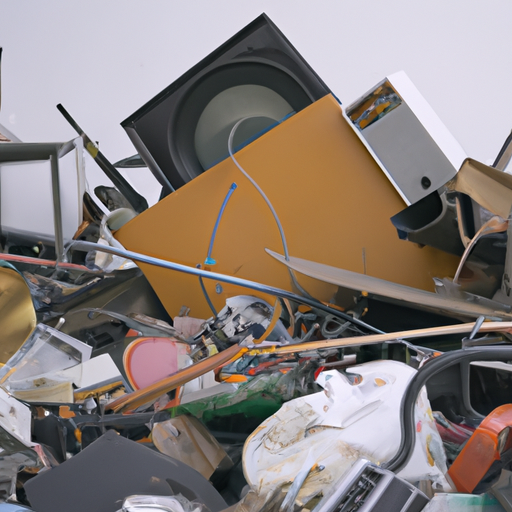“Reduce, Reuse, Recycle: Make a Difference with Ewaste!”
Introduction
Recycling e-waste is an important part of protecting the environment and conserving natural resources. E-waste, or electronic waste, is any discarded electronic device or component that is no longer in use. This includes computers, cell phones, televisions, and other electronic items. Recycling e-waste helps to reduce the amount of hazardous materials that are released into the environment, as well as conserving energy and resources. In this article, we will discuss the importance of recycling e-waste and provide tips on how to do it properly.
How to Properly Dispose of E-Waste: A Step-by-Step Guide
1. Research local e-waste disposal options. Check with your local government or waste management company to find out what e-waste disposal options are available in your area.
2. Separate your e-waste. Sort your e-waste into categories such as computers, monitors, printers, and other electronic devices.
3. Contact a certified e-waste recycler. Contact a certified e-waste recycler to arrange for the pickup or drop-off of your e-waste.
4. Prepare your e-waste for disposal. Remove all personal data from your e-waste and make sure all components are disconnected and ready for disposal.
5. Dispose of your e-waste. Drop off your e-waste at a certified e-waste recycler or have it picked up by a certified e-waste recycler.
6. Confirm your e-waste has been recycled. Ask the certified e-waste recycler for proof that your e-waste has been recycled in an environmentally responsible manner.
7. Monitor your e-waste disposal. Keep track of the e-waste you have disposed of and make sure it is recycled in an environmentally responsible manner.
The Benefits of Recycling E-Waste: Why It’s Important to Do It Right

Recycling e-waste is an important part of protecting the environment and conserving natural resources. Electronic waste, or e-waste, is any discarded electronic device or component that is no longer in use. This includes computers, televisions, cell phones, and other electronic items. E-waste is a growing problem, as more and more electronic devices are produced and discarded each year.
Recycling e-waste is beneficial for a number of reasons. First, it helps to reduce the amount of waste that is sent to landfills. Electronic waste contains hazardous materials such as lead, mercury, and cadmium, which can leach into the soil and contaminate groundwater. By recycling e-waste, these materials can be safely disposed of and kept out of the environment.
Second, recycling e-waste helps to conserve natural resources. Many of the materials used to make electronic devices, such as metals and plastics, are finite resources. By recycling these materials, we can reduce the need to extract new resources from the earth.
Third, recycling e-waste helps to create jobs. Recycling centers employ people to sort, process, and repurpose e-waste. This creates jobs and helps to stimulate the economy.
Finally, recycling e-waste helps to reduce energy consumption. Recycling centers use less energy than manufacturing plants, so recycling e-waste helps to reduce our overall energy consumption.
It is important to recycle e-waste properly. Many recycling centers accept e-waste, but not all of them are certified to do so. It is important to find a certified recycling center that follows proper safety protocols and uses the latest technology to ensure that e-waste is recycled safely and responsibly.
In conclusion, recycling e-waste is an important part of protecting the environment and conserving natural resources. It helps to reduce the amount of waste sent to landfills, conserve natural resources, create jobs, and reduce energy consumption. It is important to recycle e-waste properly, so it is important to find a certified recycling center that follows proper safety protocols.
How to Find a Local E-Waste Recycling Center: Tips for Finding the Right Place
If you are looking for a local e-waste recycling center, there are a few tips you should keep in mind to ensure you find the right place.
First, research the local e-waste recycling centers in your area. You can do this by searching online or asking your local government for a list of certified e-waste recyclers. Make sure to check the credentials of each center to ensure they are certified and have the necessary permits to recycle e-waste.
Second, contact the centers you are interested in to ask about their services. Find out what types of e-waste they accept, what their recycling process is, and what fees they charge. This will help you determine which center is the best fit for your needs.
Third, consider the location of the center. If you are looking for a local e-waste recycling center, make sure it is close enough for you to easily transport your e-waste.
Finally, ask for references. Ask the center for references from previous customers to get an idea of their customer service and quality of work.
By following these tips, you can find the right local e-waste recycling center for your needs. Doing your research and asking the right questions will help you make an informed decision and ensure you are working with a reputable center.
Conclusion
Recycling e-waste is an important step in protecting our environment and conserving natural resources. It is also a great way to reduce the amount of waste that ends up in landfills. By following the steps outlined in this article, you can help to reduce the amount of e-waste that is produced and ensure that it is recycled properly. With a little effort, we can all do our part to help protect our planet and ensure a sustainable future.
